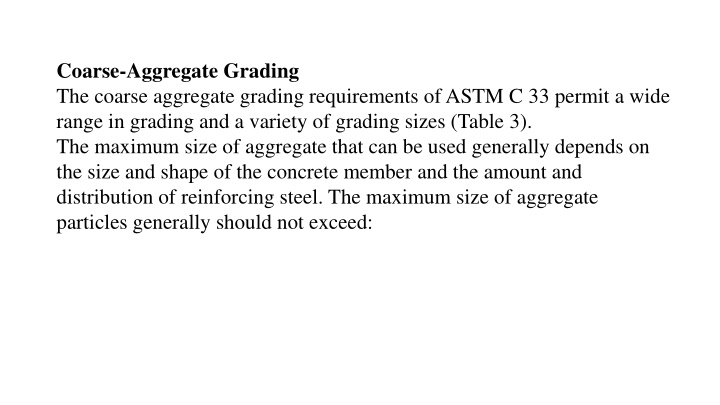
Coarse Aggregate Grading & Crushing Strength in Road Construction
Learn about ASTM C33 requirements for coarse aggregates, importance of aggregate crushing strength in road construction, and how to conduct the aggregate crushing value test using the specified apparatus and procedure. Achieving high-quality pavement involves selecting aggregates with low crushing values to ensure durability under various stresses.
Download Presentation

Please find below an Image/Link to download the presentation.
The content on the website is provided AS IS for your information and personal use only. It may not be sold, licensed, or shared on other websites without obtaining consent from the author. If you encounter any issues during the download, it is possible that the publisher has removed the file from their server.
You are allowed to download the files provided on this website for personal or commercial use, subject to the condition that they are used lawfully. All files are the property of their respective owners.
The content on the website is provided AS IS for your information and personal use only. It may not be sold, licensed, or shared on other websites without obtaining consent from the author.
E N D
Presentation Transcript
Coarse-Aggregate Grading The coarse aggregate grading requirements of ASTM C 33 permit a wide range in grading and a variety of grading sizes (Table 3). The maximum size of aggregate that can be used generally depends on the size and shape of the concrete member and the amount and distribution of reinforcing steel. The maximum size of aggregate particles generally should not exceed:
Table 3: ASTM C33 Grading Requirements for Coarse Aggregates
Strength of Aggregate -The crushing strength of aggregate: is as a ration of the weight of fine passing on a 2.36 sieve to the total weight to the sample exposed to 40 tons loads.
This is one of the major Mechanical properties required in a road stone. The test evaluates the ability of the Aggregates used in road construction to withstand the stresses induced by moving vehicles in the form of crushing. With this the aggregates should also provide sufficient resistance to crushing under the roller during construction and under rigid tyre rims of heavily loaded animal drawn vehicles. The aggregate crushing value provides a relative measure of resistance to crushing under a gradually applied compressive load.
To achieve a high quality of pavement aggregate possessing low aggregate crushing value should be preferred. The aggregate crushing value of the coarse aggregates used for cement concrete pavement at surface should not exceed 30% and aggregates used for concrete other than for wearing surfaces, shall not exceed 45%.
Apparatus: A steel cylinder of internal diameter 15.2 cm (Steel cylinder with open ends) A square base plate, plunger having a piston diameter of 15 cm. A cylindrical measure of internal diameter of 11.5 and height 18 cm. Steel tamping rod having diameter of 1.6 cm length 45 to 60 cm. Balance of capacity 3 kg with accuracy up to 1 gm. Compression testing machine capable of applying load of 40 tons at a loading rate of 4 tons per minute
Procedure: The aggregate in surface-dry condition before testing and passing 12.5 mm sieve and retained on 10 mm sieve is selected. The cylindrical measure is filled by the test sample of the aggregate in three layers of approximately equal depth, each layer being tamped 25 times by the rounded end of the tamping rod. After the third layer is tamped, the aggregates at the top of the cylindrical measure are leveled off by using the tamping rod as a straight edge. Then the test sample is weighed. Let that be WI gm. Then the cylinder of test apparatus is kept on the base plate and one third of the sample from cylindrical measure is transferred into cylinder and tamped 25 times by rounded end of the tamping rod. Similarly aggregate in three layers of approximately equal depth, each layer being tamped 25 times by rounded end of the tamping rod. Then the cylinder with test sample and plunger in position is placed on compression testing machine. Load is then applied through the plunger at a uniform rate of 4 tons per minute until the total load is 40 tons and the load is released.
Aggregates including the crushed position are removed from the cylinder and sieved on a 2.36mm sieve and material which passes this sieve is collected and weighed. Let this be W2 gm. The above step is repeated with second sample of the same aggregate. The two tests are made for the same specimen for taking an average value. Total weight of dry sample taken is WI gm weight of the portion of crushed material passing 2.36mm sieve be W2 gm.Then the aggregate crushing value is defined as the ratio of weight of fines passing the specified sieve to the total weight of the sample (WI). Aggregate crushing value = 100*W2/WI%






















